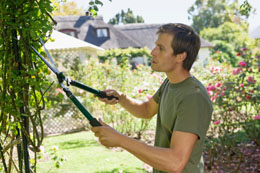With various types of pruning tools, selecting the correct one for trimming tree branches is not so easy. Tools for pruning are decided based on the size of the twigs, their height from the ground and the number of branches to be trimmed.

Pruning correctly at the ideal time is a basic aspect in maintaining shrubs, fruit trees and landscaping trees. It is usually done from the second year of planting shrubs, while trees require a longer period to get ready for pruning. The main objectives of pruning large plants are - removing weak twigs, getting rid of diseased parts, promoting light penetration and maintaining plant shape. And selecting proper tools for pruning is as important as deciding the right time for pruning.
Different Types of Pruning Tools
There is no doubt that pruning helps minimize plant problems, while increasing the tree vigor. But, knowing the basics of trimming trees is a prerequisite, especially in terms of using correct tools and selecting the branches to be pruned. Otherwise, it causes much harm by leaving large open wounds that are difficult to heal. Proper tools to use for pruning are based on certain aspects, like the branch height and size. To make your gardening task simpler, various kinds of pruning tools along with their applications are discussed below.
Hand Pruners
As the name clearly suggests, they are used for manual pruning of shrubs, bushes and small trees. Hand pruners, also known as hand clippers or shears, are excellent for trimming down branches that average 2.5 cm in diameter. Such small twigs can be pruned easily without spending much effort. In the market, you will find manual pruners with straight blades (anvil style hand pruners) and curved blades (bypass hand pruners).
Lopping Shears
If the diameter of the branch is more than an inch, lopping shears or pruning loppers with long handles are a preferred choice. They have large surface area for cutting. And provided that the size of the branches is not more than 7 cm in diameter, they can be used as tools for pruning fruit trees and other larger trees. Just like hand pruners, pruning loppers also come with straight blades and curved blades.
Hedge Shears
Hedge shears are simple tools for pruning hedge bushes and shrubs, which we maintain for decorating formal gardens and creating privacy in home gardens. These pruning equipment have elongated and flat blades. Available in manual and electric operated versions, hedge shears are ideal for trimming many young shoots at one go. So, use them if you want to give a uniform shape to shrubs and bushes.
Pruning Saws
Pruning saws are used for branches having a diameter of 10 cm. You will get small-sized folding saws that can be folded inside the handle, while the larger ones are provided with a protective sheath. Also, you can opt for pruning saws with straight and curved metal blades. The former is useful for cutting branches in different directions, while the curved blade involves pulling method to cut tree branches.
Chain Saws
These tree trimming equipment come in various types, and are ideal for cutting larger branches (more than 10 cm in diameter) with less effort. They are powered with gas or electricity, and are mostly applicable for cutting firewood in bulk. Use chain saws only if you know how to handle them properly. To be on the safer side, chain saws should be used by professionals.
Pole Pruners
When it comes to deciding the tools for pruning overhead tree twigs, pole pruner serves the ideal one. The blade configuration is nearly similar to lopping shears. The pole may be made up of aluminum, plastic and wooden materials. Models having aluminum and plastic poles are lighter and easier to use, as compared to the one with a wooden pole. However, pruners having metal poles should be used with care to avoid electrocution.
Other Tools
In addition to the actual tools for pruning, you will need ladder for trimming taller trees. It is best to lay the ladder close to the tree, or follow the recommended directions. Accessories needed for pruning project include ropes, safety harness, gloves, eye glasses, boots and other safety gears. For any challenging project, don't hesitate to hire a skilled person for pruning trees.
I hope it will be easier for you to choose proper tools for pruning trees and landscaping plants. Always sharpen the blades and keep the pruning tools in good working condition to avoid unnecessary damage or crushing of the plant parts. Last but not the least, sanitizing tree trimming equipment is suggested to minimize unwanted spread of pathogens from diseased trees to healthy ones. This can be done by rubbing the pruning tools with dilute bleach before washing with soapy water, and then drying them.






 Pruning correctly at the ideal time is a basic aspect in maintaining shrubs, fruit trees and landscaping trees. It is usually done from the second year of planting shrubs, while trees require a longer period to get ready for pruning. The main objectives of pruning large plants are - removing weak twigs, getting rid of diseased parts, promoting light penetration and maintaining plant shape. And selecting proper tools for pruning is as important as deciding the right time for pruning.
Pruning correctly at the ideal time is a basic aspect in maintaining shrubs, fruit trees and landscaping trees. It is usually done from the second year of planting shrubs, while trees require a longer period to get ready for pruning. The main objectives of pruning large plants are - removing weak twigs, getting rid of diseased parts, promoting light penetration and maintaining plant shape. And selecting proper tools for pruning is as important as deciding the right time for pruning.